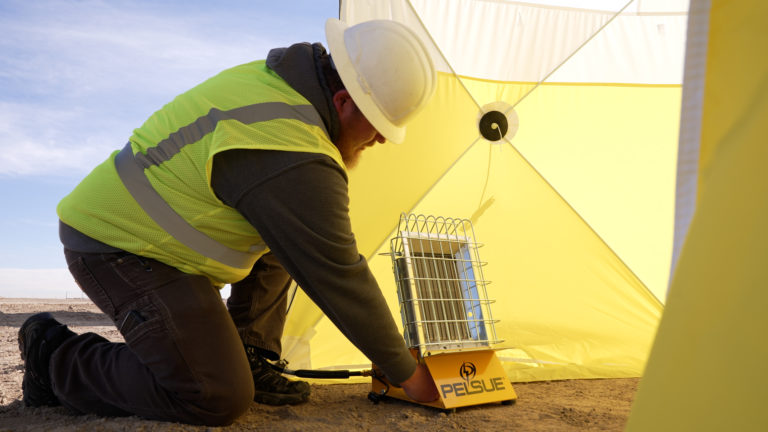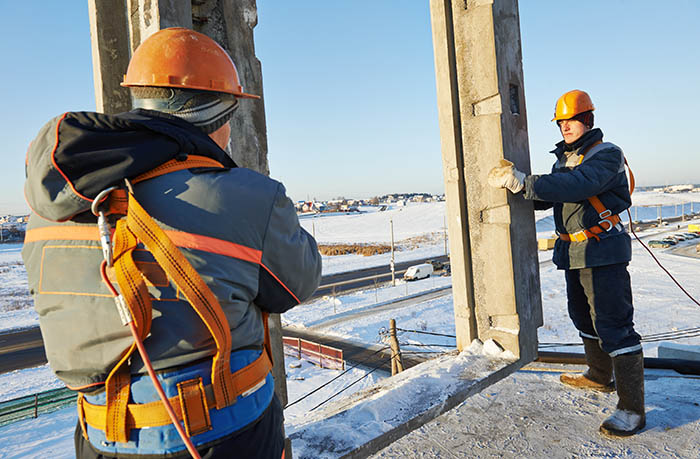7 Cold Weather Work Safety Tips
January 17, 2022
Cold and clumsy fingers, hypothermia, frostbite: it’s all more reminiscent of outdoor survival stories than workplace hazards. We want to provide you some cold weather work safety tips that will help protect workers when temperatures tumble.
According to the Bureau of Labor Statistics, 190 workers missed time on the job in 2020 due to injuries and illnesses from exposure to environmental cold. In both 2019 and 2018, 240 workers lost time for the same reason.
Compared to the dangers of heat stress (which we’ve discussed in depth in a prior blog post), that may seem small. But we believe that each one of those 190 workers matters and that these injuries and illnesses are eminently preventable.
When employers take cold weather seriously as a legitimate workplace danger, workers everywhere will be better protected. Dismissing the issue will only leave more workers exposed to life-threatening elements.
Take these work safety tips with you when you head into cold weather and better protect your workers from catastrophic, potentially life-altering accidents.
7 Cold Weather Work Safety Tips
1. Block the Wind
Here in Colorado, we’re very familiar with the concept of windchill. We know it’s not enough to just look at the forecast high for the day. The wind can quickly turn a cold but manageable day into a potential danger.
How dramatic is this effect? A 35° F (1.6° C) day can feel like a 27° F with just a 10-mph wind. In a 30-mph wind, that drops to 21.7° F, and 18° F when the wind hits 50 mph. The National Weather Service has a handy calculator to predict perceived temperatures with windchill.
Not only that, but the faster the wind blows, the more convective energy it carries. A still or slow wind will still draw heat from your body, but as speed increases, so does this effect.
For these reasons, it can be a huge lifesaver to block the wind from blowing through your worksite. Setting up a work tent large enough to accommodate your crew as they work goes a long way to fighting the hazards of cold stress.

Further, using a work tent can amplify the effect of tent heaters to create a much safer and more comfortable work area.
2. Provide Plenty of Warm Break Areas
Just as you should create a warm place to work, you should also make sure your crew has a warm place to take a break.
Your crew will need to take breaks routinely and, if an emergency occurs (as outlined below), victims of hypothermia, frostbite, and trench foot need a warm area before basic first aid can begin or emergency services arrive.
Create enough warm space where workers can take a break. As part of this tip, promote enough physical activity among workers to encourage blood flow without breaking a sweat. Also, advise workers to change into dry clothes to help prevent cold stress in the first place.
3. Bundle Up
Make sure your crews are equipped with proper clothing before they set out for the job site. Depending on the day, a jacket may not suffice for conditions and certain fabrics function better than others.
Educate workers about proper layering for cold weather to promote work safety. A breathable inner layer combined with a wool or down middle layer which can provide insulation when wet is a good base but should be topped with an outer windbreaker layer to keep evaporation from cooling the wearer.
It may be a good idea to pick up a few suitable coats from a thrift store, Army/Navy surplus, or outdoor equipment retailer to keep on hand to loan to workers without adequate layers, or who find their clothes soaked.
4. Stay Dry
Very similar to the above tip, but so important that it bears mentioning on its own is this: keep your workers from getting wet as best you can.
Air—especially still air—is not a particularly good conductor. Water, on the other hand, is great at transferring energy from one medium to another. That includes your body heat.
Not sending workers into an environment that will quickly soak through their clothes is crucial to keeping them safe. Provide heated ventilation to help dry things out, and make sure there are backup clothes for workers to change into if need be.
5. Give Workers Warm Drinks

Most of us will read this work safety tip and our minds will drift to precious coffee. But if you’re working outside, caffeine can contribute to dehydration and is generally advised against. It goes without saying that alcohol must also be avoided.
Hot chocolate is a great option, as is decaf tea or coffee. Set it up in your break area and encourage workers to bring a thermos to keep with them when they need it.
6. Salt Icy Ground
Cold stress isn’t the only danger of outdoor winter work. Slips and falls are another source of cold-weather injuries, even if we can’t put a number to it (BLS data does not break down falls according to the presence of icy conditions).
This tip should not be ignored – make sure that you and your crews put down enough road salt to melt ice around the job site. As a bonus, the large grains provide extra traction to workers.
7. Change the Culture
Lastly, evaluate the culture at your organization to ensure it promotes work safety. Are workers encouraged to report injuries, illnesses, or strange symptoms, even if it means stopping work for what may turn out to be nothing?
This is not just a cold weather safety tip, it’s one of the most important changes you can make for worker safety in general.
Create a company where workers aren’t intimidated away from coming forward, confront issues openly, and find solutions that protect safety and remind your crew that their safety matters.
The Dangers and Symptoms of Cold Stress

Work safety begins with prevention. At the most basic level, the ability to identify when workers are experiencing the symptoms of dangerous cold stress is vital to protecting workers.
There are a range of specific conditions that can occur as the result of cold stress. They can occur individually or at the same time.
Hypothermia
Hypothermia occurs when the body loses heat faster than it can regenerate it. Everyone exposed to cold weather is at risk for hypothermia, but older workers tend to be more susceptible to it, along with workers taking “anti-depressants, sedatives, tranquilizers, and some heart medications,” according to Princeton.
Mild hypothermia can set in when body temperature drops between 98- and 90-degrees Fahrenheit (36-32° Celsius). You might notice yourself or your teammates shivering, becoming uncoordinated, fumbling tools, slurring speech, or turning pale.
In and of itself, mild hypothermia isn’t that threatening. But it’s crucial that your crew recognizes its onset so they can intervene and protect themselves and each other before the situation escalates.
Below 90° F, moderate hypothermia begins with a subtle but serious shift: the affected worker will stop shivering. Shivering is one of the body’s reflexive mechanisms to keep itself warm, but as the extremities shut down to protect the core, so does shivering.
When is the absence of shivering a sign of moderate hypothermia as opposed to a return to normal body temperature? One of the best ways to tell the difference is to look to the worker’s behavior.
Patients in the grips of moderate hypothermia often exhibit signs of confusion or impaired or irrational thinking. Additionally, they may have trouble standing or walking. Check their breathing and heart rate, as both will be noticeably slow.
As soon as you notice signs of mild hypothermia, move the affected worker(s) to an appointed warm area (as mentioned in work safety Tip 2 above), use light physical activity to keep muscles working, replace any wet clothes with dry clothes or blankets, and provide warm (not hot) sugary liquids.
More on these measures can be found below. If the stricken worker shows signs of moderate hypothermia, call 911 immediately, place hot water bottles or packs on the victim’s head, neck, chest, and groin, and cover all exposed extremities.
If body temperature drops below 86° F (30° C), hypothermia grows severe, and the situation becomes much more critical and the response changes.
At this stage, muscles become very stiff, and the pulse becomes irregular or difficult to detect at all. The afflicted will grow noticeably sleepy and may even slip into unconsciousness. Death becomes an immediate threat as when the body’s temperature passes the 78° F (25.5° C) threshold.
While your first action should still be calling emergency services, handling a case of severe hypothermia is very different than a moderate one.
You should still relocate the victim to a warm area, but sudden or rough movement may interrupt heart rhythms or even stop the heart. For the same reason, avoid applying direct heat to the person which can additionally cause skin damage.
While hypothermia is the most common expression of cold stress and a danger to work safety, it’s by no means the only one.
Frostbite
Frostbite is familiar to many people as a dire threat faced by climbers on Everest or Antarctic explorers. But frostbite can just as easily affect anyone outdoors in cold weather for a prolonged time.
In frostbite victims, the skin freezes and treatment may require amputation. It’s especially important, then, to recognize the signs and risk factors for frostbite before a potentially life-altering event happens.
If a coworker reports a cold, aching, stinging, or tingling feeling followed by numbness, they may be experiencing the early stages of frostbite. Check for skin that is cold to the touch or turning red, then purple, then white. Skin may even be hard or blistered.
Immediately call 911 and wrap the affected area in soft fabric. Do not attempt to rub the area to warm it, as that may damage the tissue. If help will take a while to arrive, immerse the affected area in warm (not hot) water.
If there is a risk of refreezing, however, do not immerse in water. Your main focus should be on preserving the tissue without subjecting it to further stress from cold or abrasion.
Trench foot
Trench foot is similar to frostbite, though usually less severe. It’s also called immersion foot, which is a big hint as to how it happens: immersing the feet in cold water, mud, or snow.
If you or a coworker feels tingling, burning, or itching, or finds blisters on wet, cold feet, soak the affected foot in warm water and wrap in dry bandages. Drink a warm, sugar-rich drink while recuperating.
When the cold hits, your crews face considerable risks to their health. But with proper planning, training, and equipment the hazards can be minimized and serious illness or injury can become less of a danger.

